Share article:
11 golden rules for how to write SMS for marketing

You’ve just integrated text messages into your marketing strategy and want to create successful SMS campaigns? You’ve come to the right place! We’ve put together eleven tips for how to write SMS for marketing.
When it comes to connecting with your customers, you should never underestimate the power of a text message. It’s familiar, instant, personal and unobtrusive — all at the same time — giving you a quick and easy way to reach out.
Yet despite the fact that everyone uses text messaging all of the time, many businesses still get it wrong. And now that customers can easily block messages, even the slightest mistake can be costly. So when someone gives you their phone number, you want to make it count.
Here are eleven golden rules for how to write SMS for marketing purposes. Follow these rules to send messages that connect with your customers, each and every time.
1. Have something to say
Text messages have open rates of 98% as most people read SMS within minutes of receiving them. That’s why SMS marketing campaigns can reach incredible click-through rates of up to 36%. However, you can only reach these metrics if your message is truly meaningful. Before blasting your audience with unwanted text messages, consider what type of content they would be interested in. Then craft your campaigns around that. If you’re not sure, ask them in a survey!
The better you understand your target audience the more successful your SMS marketing will be.
2. Be clear
SMS feels more personal than other channels. Lean into this. Be clear about why you’re getting in touch, or show them why you think they’ll be interested in whatever you’re promoting. This transparency will help show that your message isn’t spam.
Likewise, if there’s something they need to do with the message, spell it out. For example, do they need to keep the message to show in-store? Tell them. Do they need to reply Y or N to confirm an appointment? Make it known.
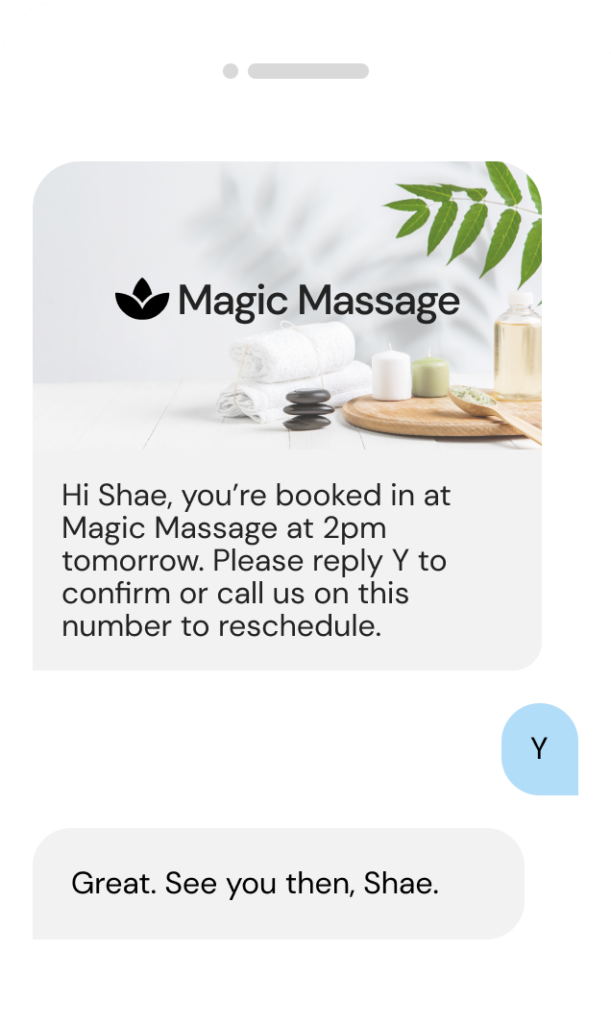
3. Time it right
Most people have their phones with them. All. The. Time. But it doesn’t mean they want to get a notification from you at 9pm on a Friday night. Generally, the best time to send business messages is mid to late afternoon on weekdays. Of course, this isn’t true for every brand. If you’re reaching out to a commuter audience, 7am might be a much better time for them to read your texts on their way to work. Busy parents, on the other hand, will have more time to check their messages after bedtime.
Feel free to experiment until you find the best timing for your target audience. Don’t forget to consider different timezones if your customers come from different geographic areas. With professional SMS marketing tools, you can also schedule your messages, so you don’t have to manually send them in the middle of the night.
While timing’s on your mind, remember that time-bound texts can work a treat if you’ve got a limited-time offer coming up.
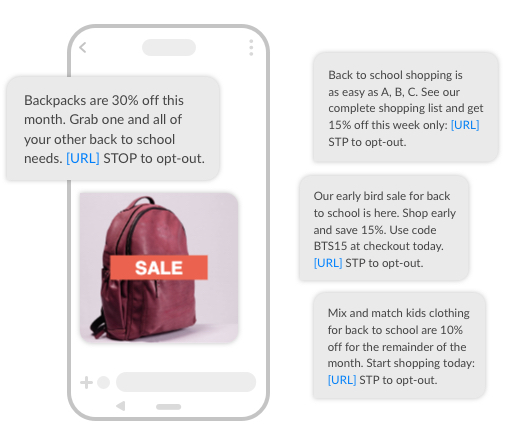
Ready to hit the ground running?
Start a 14-day free trial with Sinch MessageMedia and see how easy it is to craft successful SMS campaigns.

4. Avoid inappropriate txt speak
Do you use acronyms IRL? Ever write “ur” instead of “your” in an email? Unlikely. Be true to your brand values by using the words and grammar you’d use in all your other marketing communications. If you try to be clever with text-speak, you could end up alienating people. ICYMI (in case you missed it), your customers don’t have time to decipher all your shorthand.
Now, if your customers actually DO use text speak and this is what your brand is about, by all means, GFI!
5. Keep it short and sweet
That said, if you’re not using acronyms, you still need to keep your messages short, as you’ve only got 160 characters to get your message across. Keep things succinct and steer clear of jargon (and fluff).
To keep things brief, follow this format for your SMS: introduce yourself, state the purpose of the text, and include a clear call to action. Of course, there are always going to be times when you need to say more — and you can make your messages longer if the need arises. But for standard texts, less is best.
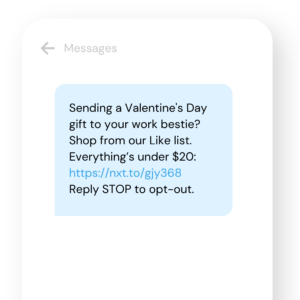
6. Make it personal
When thinking about how to write SMS for marketing, staying close to your audience is key. To do this, you need to make it personal. Use your customer’s name, and customise the message with any other information that could be relevant to them — like their location, their shopping preferences, or how they’ve interacted with you in the past.
Most SMS marketing tools will have automations set up that let you add variables to a template. With these, you just add a variable like #FirstName# once when you set up your message, while each reader gets a personalised SMS.
7. Segment your audience
When thinking about how to write SMS for marketing, reaching the right target group is essential for engagement and conversions. So, aside from sending valuable content and getting the timing right, it’s also important to segment your audience. After all, sending a promo code for a new dog treat won’t be interesting for cat parents.
You can easily create target groups by integrating your CRM systems like Zoho or Salesforce with your SMS marketing platform.
8. Introduce yourself
How will your customers know your message is from you? To help build familiarity, consider using an SMS Alpha Tag, which replaces your phone number with a name of your choosing. Alternatively, you could use a dedicated number each time you send — if you go down this path, it’s a good idea to include your company name in your message so your customers don’t mistake your message for spam.
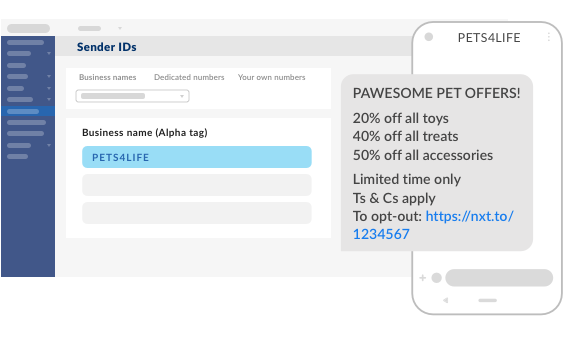
9. Add alluring imagery
Grab your customers’ attention by adding a beautiful image to your text message. Use MMS to add eye-catching visuals, or take things further by building mobile landing pages that you can personalise for every customer.
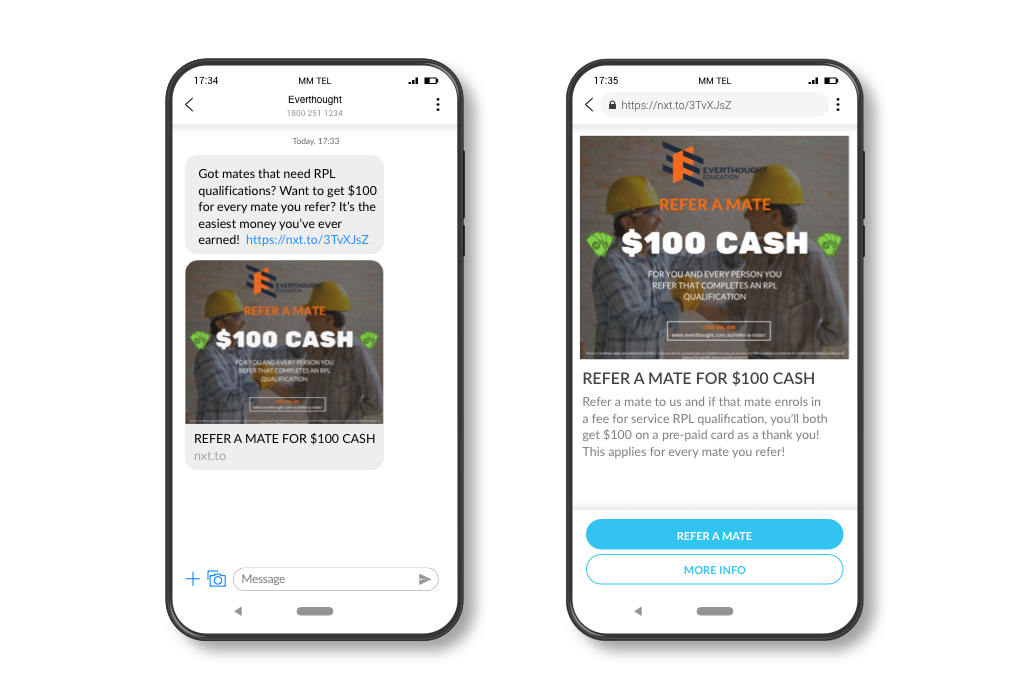
10. Brush up on regulations
If you’re sending out marketing messages to (potential) customers, you need to follow certain regulations like the Australian Spam Act. This includes getting your recipients’ prior consent (opt-in), stating clearly who you are and what the purpose of the message is, leaving your contact information, and offering a way to opt-out as well.
11. Check, test, modify, repeat
Triple-check your message before you hit ‘send’. The last thing you want is an embarrassing typo or awkward autocorrect. Don’t forget to check that your texts comply with the rules — and always include the easy ability to opt out of future messages.
Once sent, track response rates and use the insights to continually improve your messages. For example, you could test different offers to see what gets the most traction, or compare SMS to MMS to see what’s most effective.
How to write SMS for marketing: Ready to hit the market
With the above tips in mind, you’re ready to start marketing with SMS. Whether you use it for sales promotions, appointment reminders, payment reminders, special offers or something else entirely, these best practices will help you get the best possible returns and lowest possible unsubscribe rates.
Got questions about getting started? Reach out to Sinch MessageMedia — we’re here to help make your marketing work smarter.
